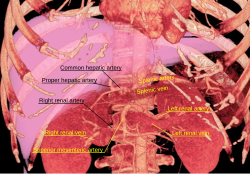The common hepatic artery is a short blood vessel that supplies oxygenated blood to the liver, pylorus of the stomach, duodenum, pancreas, and gallbladder.[1]
| Common hepatic artery | |
|---|---|
 Branches of the celiac artery - stomach in situ. (Hepatic artery is visible at upper left.) | |
 3D-rendered computed tomography, showing common hepatic artery in center | |
| Details | |
| Source | Celiac artery |
| Branches | Hepatic artery proper gastroduodenal artery |
| Identifiers | |
| Latin | arteria hepatica communis |
| MeSH | D006499 |
| TA98 | A12.2.12.015 |
| TA2 | 4214 |
| FMA | 14771 |
| Anatomical terminology | |
It arises from the celiac artery[2] and has the following branches:[3]
| Branch | Details |
|---|---|
| hepatic artery proper | supplies the gallbladder via the cystic artery and the liver via the left and right hepatic arteries |
| gastroduodenal artery | branches into the right gastroepiploic artery and superior pancreaticoduodenal artery |
| right gastric artery | branches to supply the lesser curvature of the stomach inferiorly |
Additional images
edit-
Common hepatic artery and its branches including hepatic artery proper and right gastric artery (pyloric artery)
References
edit- ^ "Common Hepatic Artery - an overview | ScienceDirect Topics". www.sciencedirect.com. Retrieved 2022-03-27.
- ^ "Common hepatic artery". Kenhub. Retrieved 2022-03-27.
- ^ D'Souza, Donna. "Common hepatic artery | Radiology Reference Article | Radiopaedia.org". Radiopaedia. Retrieved 2022-03-27.
External links
edit- Anatomy photo:38:03-0204 at the SUNY Downstate Medical Center - "Stomach, Spleen and Liver: Contents of the Hepatoduodenal ligament"
- celiactrunk at The Anatomy Lesson by Wesley Norman (Georgetown University)